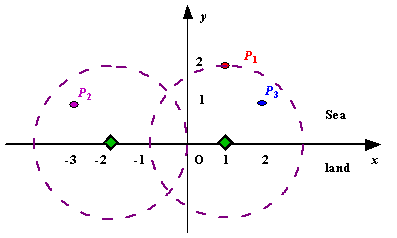POJ 1328 Radar Installation 贪心
来源:互联网 发布:深圳教苑中学 知乎 编辑:程序博客网 时间:2024/05/22 15:45
Description
Assume the coasting is an infinite straight line. Land is in one side of coasting, sea in the other. Each small island is a point locating in the sea side. And any radar installation, locating on the coasting, can only cover d distance, so an island in the sea can be covered by a radius installation, if the distance between them is at most d.
We use Cartesian coordinate system, defining the coasting is the x-axis. The sea side is above x-axis, and the land side below. Given the position of each island in the sea, and given the distance of the coverage of the radar installation, your task is to write a program to find the minimal number of radar installations to cover all the islands. Note that the position of an island is represented by its x-y coordinates.

Figure A Sample Input of Radar Installations
We use Cartesian coordinate system, defining the coasting is the x-axis. The sea side is above x-axis, and the land side below. Given the position of each island in the sea, and given the distance of the coverage of the radar installation, your task is to write a program to find the minimal number of radar installations to cover all the islands. Note that the position of an island is represented by its x-y coordinates.

Figure A Sample Input of Radar Installations
Input
The input consists of several test cases. The first line of each case contains two integers n (1<=n<=1000) and d, where n is the number of islands in the sea and d is the distance of coverage of the radar installation. This is followed by n lines each containing two integers representing the coordinate of the position of each island. Then a blank line follows to separate the cases.
The input is terminated by a line containing pair of zeros
The input is terminated by a line containing pair of zeros
Output
For each test case output one line consisting of the test case number followed by the minimal number of radar installations needed. "-1" installation means no solution for that case.
Sample Input
3 21 2-3 12 11 20 20 0
Sample Output
Case 1: 2<p>Case 2: 1</p>
题意 :有n个小岛 并给出海岸线上雷达覆盖的半径d,雷达只能放置于海岸线上(x轴),给出每个小岛的坐标,问至少要多少个雷达才能把小岛全部覆盖。
代码:
#include<iostream>#include<cstdio>#include<cmath>#include<algorithm>using namespace std;struct node{double l,r;}q[1002];bool cmp(node a,node b){return a.r<b.r;}int main(){int m,n,a,b,i,t,k=0,s;while(cin>>m>>n){k++;t=0; if(m==0&&n==0)break;s=1;for(i=0;i<m;i++){cin>>a>>b;if(b>n) //如果某岛y值大于半径 一定不能覆盖t=1; q[i].l=a-sqrt((double)n*n-b*b);q[i].r=a+sqrt((double)n*n-b*b); //求出每个岛要被覆盖 能放置的雷达区域}if(t==1){cout<<"Case "<<k<<": -1"<<endl;continue;}sort(q,q+m,cmp); //关于右端排序double ld=q[0].r;for(i=1;i<m;i++){if(q[i].l>ld) {s++;ld=q[i].r;}else if(q[i].r<ld)ld=q[i].r;}cout<<"Case "<<k<<": "<<s<<endl;}return 0;}将每个小岛的能安置的雷达区间求出来,然后对每个区间的右端点按从小到大排序,将第一个雷达放在第一个区间的右端点,然后对下一个区间进行判断:1.如果下一个区间的左端点在雷达的右边,那么雷达一定不能覆盖到下一个岛屿,雷达数加1,将新雷达放置在下一个区间的右端点2.如果下一个区间的右端点在雷达的左边,那么雷达能够覆盖,将雷达放置到下一个区间的右端点3.如果下一个区间的左端点在雷达的左边,右端点在雷达的右边,即两个区间相交,那么雷达能覆盖下一个岛屿,雷达位置不变注意用double处理
0 0
- POJ 1328 Radar Installation(贪心)
- POJ 1328 Radar Installation 贪心
- POJ 1328 Radar Installation 贪心
- POJ 1328 贪心 Radar Installation
- POJ 1328 Radar Installation 贪心
- POJ | 1328 Radar Installation | 贪心
- POJ 1328 Radar Installation 贪心
- 贪心-poj-1328-Radar Installation
- POJ 1328 Radar Installation (贪心)
- POJ 1328 Radar Installation 贪心
- POJ 1328 Radar Installation 贪心
- POJ 1328、Radar Installation 贪心
- poj 1328 Radar Installation(贪心)
- POJ 1328 Radar Installation 贪心
- POJ 1328 Radar Installation 贪心
- POJ 1328 Radar Installation 贪心
- Poj 1328 Radar Installation 贪心
- POJ--1328:Radar Installation (贪心)
- java中几种排序算法
- 当页面特殊无法执行js时写的代码方法
- listview 和 button 共存的问题
- cocos2d-x3.1基于Mac创建iOS项目
- 为Hadoop的MapReduce程序编写makefile
- POJ 1328 Radar Installation 贪心
- Android学习笔记之AndroidManifest.xml文件解析
- 单例模式学习笔记
- 我是如何来定时发布文章的
- Mysql:is not allowed to connect to this MySQL server
- ios 程序启动执行顺序
- android之ImageView
- UVA 10003 Cutting Sticks
- 【队列】poj1250 Tanning Salon


